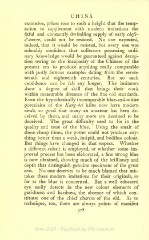Page 460 - Oriental Series Japan and China, Brinkly
P. 460
CHINA
extensive, prices rose to such a height that the temp-
tation to supplement with modern imitations the
fitful and constantly dwindling supply of early chefs-
Nod'aruvre, could not be resisted. one expected,
indeed, that it would be resisted, but every one was
tolerably confident that collectors possessing ordi-
nary knowledge would be guaranteed against decep-
tion owing to the incapacity of the Chinese of the
present era to produce anything really comparable
with justly famous examples dating from the seven-
teenth and eighteenth centuries. But no such
confidence can be felt any longer. The imitators
show a degree of skill that brings their work
within measurable distance of the fine old standards.
Even the hypothetically incomparable blue-and-white
porcelains of the Kang-hsi kilns now have modern
rivals so good that many an amateur has been de-
ceived by them, and many more are destined to be
deceived. The great difficulty used to lie in the
quality and tone of the blue. Using the smalt of
these cheap times, the potter could not produce any-
thing better than a weak, insipid, and bodiless colour.
But things have changed in that respect. Whether
a different cobalt is employed, or whether some im-
proved process has been elaborated, a fine strong blue
is now obtained, showing much of the brilliancy and
depth that distinguish genuine specimens of the great
eras. No one deserves to be much blamed that mis-
takes these modern imitations for their originals, so
far as the blue is concerned. But a well educated
eye easily detects in the new colour elements of
garishness and hardness, the absence of which con-
stitutes one of the chief charms of the old. As to
technique, too, there are always points of manifest
378

